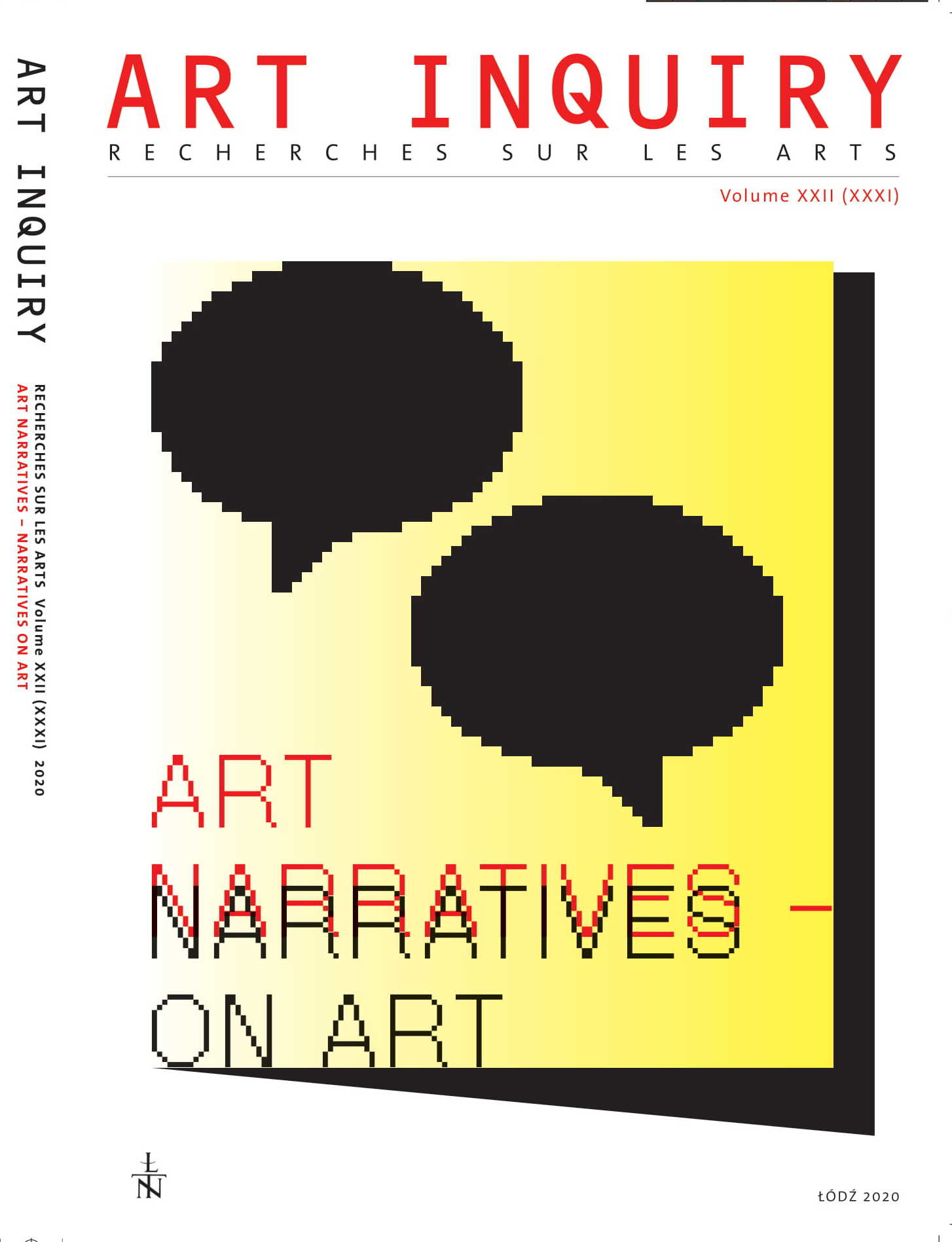Narratives about architecture
DOI:
https://doi.org/10.26485/AI/2020/22/11Keywords:
architectural heritage, post-industrial architecture, architectural protectionAbstract
Contemporary research on cities has shifted its focus from analysing formal features to aspects related to change and interaction dynamics. Seeing a city with its architecture as a system of mutual interactions and connections enables us to consider and analyse the relationships, processes, heterogeneous meanings and interpretative possibilities.
Thanks to this approach, we can explore diverse narratives focusing on architectural objects, shaped by, among others, changing social, political or economic conditions, as well as those resulting from the implementation of various conservation concepts.
The article presents these issues primarily with reference to creating contemporary narratives and, at the same time, reinterpreting architectural heritage important for the local community.
It is a particularly interesting and current issue, given the fact that, in contrast to other fields of art, the analysis of architecture is still dominated by an approach which defines objects in a static, objective and finite way.
References
Assmann Aleida (2013) Między historią a pamięcią. Antologia, M. Sariusz-Wolska ed., Warszawa: Wydawnictwo Uniwersytetu Warszawskiego.
Barndt Kerstin (2010) “Memory Traces of an Abandoned of Futures”. Industrial Ruins in the Postindustrial Landscapes of Germany, [in:] J. Hell, A. Schönle eds., Ruins of Modernity, Durham-London: Duke University Press, pp. 270-293.
Bauman Zygmunt (2000) Liquid Modernity, Cambridge: Polity Press.
Bauman Zygmunt, Kultura w płynnej nowoczesności, Agora, Warszawa 2011.
Benjamin Walter (2013) Źródło dramatu żałobnego w Niemczech, transl. Andrzej Kopacki, War¬szawa: Sic!.
Bishop Peter, Williams Lesley (2012) The Tempory City, London-New York: Routledge.
Castellas Manuel (2001) The Invention of the Historic Monument, Cambridge: Cambridge Uni¬versity Press.
Congress on the European Architectural Heritage (1975) The Declaration of Amsterdam, Am¬sterdam.
Council of Europe (1975) European Charter of the Architectural Heritage.
Council of Europe (1985) Conversation for the Protection of the Architectural Heritage of Europe, Grenada.
Council of Europe (2005) Framework Convention on the Value of Cultural Heritage Society (Faro Convention), Faro.
Feilden Bernard M. (2003) Conversation of Historic Buildings, Oxford: Architectural Press.
Giedion Sigfried (1967) Space, Time and Architejture: the Growth of a New Tradition, Cambridge-Massachusetts: Harvard University Press.
Graham Stephen, Healy Patsy (1999) Relational Concepts of Space and Place: Issues for Planning Theory and Practice, “European Planning Studies”, vol. 7, no. 5, pp.623-646.
Healy Patsy (2007) Urban Complexity and Spatial Strategies: Towards a Rational Planning for Our Times, London-New York: Routledge.
Huyssen Andreas (2006) Nostalgia for Ruins, “Grey Room”, no. 23, pp. 6-21.
International Council of Monument and Sites (1964) International Charter for the conservation and Restoration of Monuments and Sites (The Venice Charter), Venise.
International Council of Monument and Sites (1987) Charter for the Conservation of Historic towns and Urban Areas (Washington Charter), Washington.
International Council of Monument and Sites (1999) The Australia ICOMOS Charter for Places of Cultural Significance (The Burra Charter) with Associates Guidelines and Code on the Ethics of Co-existence.
International Council of Monument and Sites (2003) ICOMOS Charter - Principles for the Analy¬sis, Conservation and Structural Restoration of Architectural Heritage, Zimbabwe.
Koselleck Reinhart (2012) Warstwy czasu. Studia z metahistorii, transl. Krystyna Krzemieniowa, Jarosław Merecki, Warszawa: Oficyna Naukowa.
Latz Peter (2016) RUST RED - The Landscape Park Duisburg-Nord, München: Hirmer Publi¬shers.
Lefebvre Henri (2012) Prawo do miasta, transl. E. Majewska, Ł. Stanek, “Praktyka Teoretyczna”, no. 5, pp. 183-197.
Lynch Kevin (1960) The Image of the City, Cambridge-London: M.I.T Press.
Machado Rodolfo (1976) Towards a Theory of Remodelling. Old Buildings as Palimpsest, “Progres¬sive Architecture”, no. 11, pp. 46-49.
Mason Randall (2002) Assessing Values in Conservation Planning: Methodological Issues and Cho¬ices, [in:] M. De la Torre ed., Assessing the Values of Cultural Heritage: Research Report, Los Angeles: Getty Conservation Institute, pp. 5-30.
NODH. Duisburg-Nord – Blast Furnace Park, https://www.latzundpartner.de/en/projekte/postin¬dustrielle-landschaften/duisburg-nord-hochofenpark/ (26.07.2020).
Nora Pierre (2001) Czas pamięci, transl. W. Dłuski, “Res Publica Nowa”, no. 7, pp. 37–43.
Nora Pierre (2009) Między pamięcią a historią: les lieux de mémoire, “Tytuł roboczy: archiwum”, transl. Paweł Mościcki, no. 2, pp. 4–12.
Nyka Lucyna (2003) W kierunku zmiennej metafory miasta – miejsca, zdarzenia, krajobrazy [in:] S. Gzell ed., Kazimierz Wejchert: teoria kompozycji urbanistycznej, Warszawa: Akapit-DTP, pp. 52-61.
Nyka Lucyna (2006) Od architektury cyrkulacji do urbanistycznych krajobrazów, Gdańsk: Wydaw¬nictwo Politechniki Gdańskiej.
Pérez de Arce Rodrigo (1978) Urban Transformations and the Architecture of Additions, “Architec¬tural Design”, no. 4, pp. 237–266.
Plevouts Bie, Sowińska-Heim Julia (2018) Community initiatives as a catalyst for regeneration of heritage sites: Vernacular transformation and its influence on the formal adaptive reuse practice, “Cities”, vol. 78, pp. 128–139.
Pomian Krzysztof (1995) Jak uprawiać historię kultury, “Przegląd Historyczny”, vol. 86, issue 1, pp. 1–13.
Poulios Ioannis (2014) Discussing Strategy in heritage conservation: Living Heritage Approach as an example of Strategic Innovation, “Journal of Cultural Heritage Management and Sustainable Development”, vol. 4 pp. 16–34.
Rewers Ewa (1998) Zdarzenie w przestrzeni miejskiej, [in:] J. S. Wojciechowski, A. Zeidler-Jani¬szewska, eds., Formy estetyzacji przestrzeni publicznej, Warszawa: Instytut Kultury, pp. 87–100.
Rewers Ewa (2000) Niepewny urok tożsamości, [in:] T. Kostyrko, T. Zgółka eds., Kultura wobec kręgów tożsamości. Materiały konferencji przedkongresowej, Poznań 19–21 października 2000, Po¬znań–Wrocław 2000, pp. 109–119;
Rossi Aldo (1982) The Architecture of the City, Cambridge–Massachusetts–London: The MIT Press.
Scott Fred (2007) On Altering Architecture, London-New York: Routledge.
Sowińska-Heim Julia (2018) Transformacje i redefinicje. Adaptacja dziedzictwa architektonicznego do nowej funkcji a zachowanie ciągłości historycznej miejsca, Łódź: Wydawnictwo Uniwersytetu Łódzkiego.
Steinmetz George (2010), Colonial Melancholy and Fordist Nostalgia. The Ruinscapes of Namibia and Detroit, [in:] J. Hell, A. Schönle eds., Ruins of Modernity, Durham–London: Duke University Press, pp. 294–320.
Storm Ann (2014) Post-Industrial Landscape Scars, New York: Palgrave Macmillan.
UNESCO (1972) Convention Concerning the Protection of the World Cultural and Natural Herita¬ge, Paris.
UNESCO (1976) Recommendation concerning the Safeguarding and Contemporary Role of Histo¬ric Areas, Nairobi.
Vitruvius (1914) The Ten Book on Architecture, transl. M. H. Morgan, Cambridge: Harvard Uni¬versity Press.
Vitruvius (2009) On Architecture, transl. R. Schofield, London: Penguin Classics.
Weilacher Udo (2009) Learning from Duisburg-Nord, https://www.researchgate.net/ publicatio¬n/272166777 (access: 12.06.2018).
Yu Kongjian (2009) The Aesthetic of the Rustic, [in:] U. Weilacher ed., Learning from Duisburg-Nord, München: Technische Universität, pp. 78-79.



